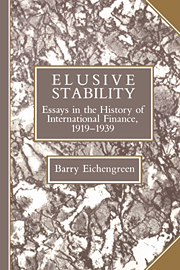Book contents
- Frontmatter
- Contents
- List of tables
- List of figures
- Acknowledgments
- 1 Introduction
- 2 Real exchange rate behavior under alternative international monetary regimes
- 3 Understanding 1921–1927: inflation and economic recovery in the 1920s
- 4 Bank Rate policy under the interwar gold standard
- 5 The Bank of France and the sterilization of gold, 1926–1932
- 6 International policy coordination in historical perspective: a view from the interwar years
- 7 The economic consequences of the franc Poincaré
- 8 Sterling and the tariff, 1929–1932
- 9 Exchange rates and economic recovery in the 1930s
- 10 The gold-exchange standard and the Great Depression
- 11 Hegemonic stability theories of the international monetary system
- References
- Index
9 - Exchange rates and economic recovery in the 1930s
Published online by Cambridge University Press: 21 March 2010
- Frontmatter
- Contents
- List of tables
- List of figures
- Acknowledgments
- 1 Introduction
- 2 Real exchange rate behavior under alternative international monetary regimes
- 3 Understanding 1921–1927: inflation and economic recovery in the 1920s
- 4 Bank Rate policy under the interwar gold standard
- 5 The Bank of France and the sterilization of gold, 1926–1932
- 6 International policy coordination in historical perspective: a view from the interwar years
- 7 The economic consequences of the franc Poincaré
- 8 Sterling and the tariff, 1929–1932
- 9 Exchange rates and economic recovery in the 1930s
- 10 The gold-exchange standard and the Great Depression
- 11 Hegemonic stability theories of the international monetary system
- References
- Index
Summary
Whether they are concerned with the magnitude of the initial contraction or the retardation of the subsequent recovery, most analyses of the Great Depression attach considerable weight to the effects of economic policy. The misguided actions of the Federal Reserve and the unfortunate commercial initiatives of the executive and legislative branches are blamed for transforming the American recession into an unprecedented depression. Perverse monetary and fiscal responses in such countries as Germany and France are blamed for reinforcing the deflationary pressures transmitted from the United States to the rest of the industrial world. In desperate attempts to promote recovery, or at least to provide insulation from destabilizing foreign shocks, national authorities had recourse to currency devaluation and tariff escalation. Such initiatives are typically characterized as beggar-thy-neighbor policies. Individually they are seen as attempts to better a country's position at the expense of its neighbors; together, it is argued, they disrupted international economic relations and, by impeding foreign trade, destroyed one of the only remaining sources of autonomous demand.
With notable exceptions, such as “cheap money” in Britain after 1931, fiscal expansion in Sweden, and industrial policy giving way to central control in Germany, public policy receives little credit for helping the economies of Europe find their way out of the Great Depression. One can conceive of various policies these nations might have pursued: devaluation, protection, monetary expansion, and fiscal stimulus.
- Type
- Chapter
- Information
- Elusive StabilityEssays in the History of International Finance, 1919–1939, pp. 215 - 238Publisher: Cambridge University PressPrint publication year: 1990



